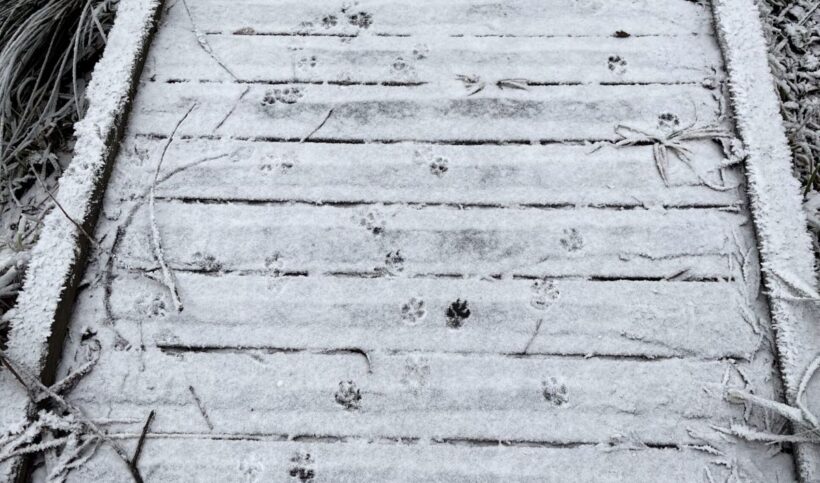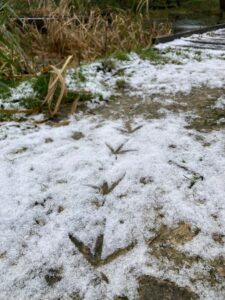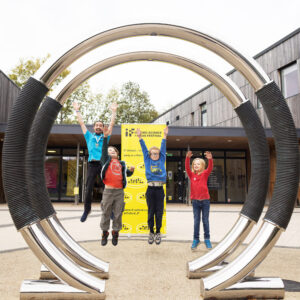Wild tracking
Monday 10th February 2025

With every Science or Nature Club I develop, my preparation takes me down a wonderful rabbit hole of information. There is so much to explore about every topic – whether it’s the varied species of British earthworms or what actually makes purple look purple!
Recently, I’ve been delving into animal tracking and the clues and signs animals leave behind that tell us about their daily lives – what lives where, what they eat, and how they move.
Tracking is an ancient art that used to be crucial for survival. While most people of the world today don’t need to track animals for food or to stay safe from predators, it remains an invaluable art, and is a particularly important tool for scientists studying the health of ecosystems.
Footprints and tracks
Like a tracker attuned to spotting clues, I have found information and ideas for the club popping up everywhere. The overnight January snows suddenly revealed the hidden activities of nocturnal animals. Their tracks criss-crossing gardens, fields and the woodland showed the nights were much busier than I had imagined! Even after the snow melted, I kept noticing them in the muddy ground left behind.
Tracks hold a wealth of information. Apart from being able to identify animals from characteristic patterns of their prints, experts can read so much more from tracks. They can tell how old a footprint is, the size of the animal that left it, and even how fast the animal was moving, all from observations like how far apart prints are, how deep they go and how faded they are.

Ancient tracks and the dinosaur ‘highway’
Preserved and ancient footprints have stories to tell too. Palaeontologists can learn as much from ancient footprints as trackers can from recent ones.
A recent discovery of dinosaur tracks near Oxford is revealing more about the lives of dinosaurs. 166 million years ago, four plant eating sauropods and a carnivorous Megalosaurus walked across a shallow lagoon, leaving deep footprints in the mud. Something happened, possibly a storm, which covered the footprints in softer clay, preserving them as they compressed and hardened into rock over millions of years. I look forward to all that can be revealed as researchers continue to study these trackways. If you’re interested in the discovery, listen to a discussion on YouTube with researchers involved.
Feathers, fur and skins
You may have spotted fallen feathers, tufts of animal fur, or reptile skin left behind, but have you thought about how much these can tell us? It took walking with my ornithologist friend for me to realise how much I could learn from feathers found in leaf litter. She had discovered a blue-tit’s favourite preening spot. Over a week, she had collected a full set of flight feathers as they were shed a pair at a time, and from her collection, she could tell in what order their feathers moult and how long it took.
Scat
For many people, one of the least welcome things animals leave behind is their scat – aka poo. However, to a scientist studying animals, scat is precious! It is so valuable that some scientists even use specially trained dogs to find it. Dogs can sniff out the scat of a particular species, and when found, will sit or lie down next to the scat to show exactly where it is. Listen to this podcast about how trained animals help scientists, or watch this Cheetah Conservation Fund video on YouTube to learn about how a scat detection dog is being used in cheetah conservation in Namibia.
Different species produce completely different shapes, sizes and textures of scat, so one can tell which animals have been present in an area. An animal’s scat also tells you exactly what it has been eating. Hedgehog scat can appear sparkly with the wing cases of insects, while badger scat during autumn is almost entirely berry stones and skin – it hardly looks like poo at all. Like tracks, scat can also be fossilised over time to reveal intimate details of ancient animals. Look out for fossilised dinosaur poo in our ‘Guess What’ exhibit in the Exploration Zone!
Scientists studying particular endangered populations may carry out genetic analysis on scat samples, which helps them identify specific individuals, whether they have any diseases and exactly what species they have been eating.
Modern tracking
Modern technology is adding to the art of tracking, and enhancing our understanding of ecosystems and conservation efforts. Radio and GPS collars mean individual animals can be followed, while camera traps provide photo and video evidence of which animals have been in an area, and how they behave when no humans are present. Read more about some of the ways tracking technology is transforming our understanding of animal behaviour in this article on The Conversation.
Five Wild-Trackingly-Good Things to do:
Are you interested in tracking the ‘wild’ near you? Here are some ideas for family activities:
- Come to Nature Clubs at the Science Oxford Centre for ages 5-9 with themed sessions coming up to help you become nature investigators.
- Join us at a Family Day at the Science Oxford Centre and hunt for tracks in the woodland with an Explorer Backpack! On Saturdays in March, learn more about fossils on loan from the Oxford University Museum of Natural History (OUMNH) at ‘Paleo Puzzle’ Live Lab.
- See dinosaur prints from Oxfordshire at the OUMNH Breaking Ground exhibition and learn more about clues left behind in fossils by ancient animals.
- Try wild tracking near you. Look closely at the world around you. Observing prints, feathers and fur and even animal poo can give you a window into the secret lives of the wildlife around us. You could make an animal print “trap” to see what animals visit your garden. Share what you find on social media and tag us.
- It’s not only animals you can track by observing clues and signs in your environment. Join in tracking of the seasons and look out for signs of Spring. Observe and record the vital signs of Spring and help the Woodland Trust check the health of nature.



